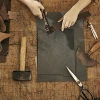19 careers found.
Clothing and soft furnishing production workers are involved in all stages of production, from marking and cutting the fabric through to finishing the item.
Clothing patternmakers produce master patterns from designs. They work closely with designers, interpreting their sketches to develop a style that can be achieved by the company's equipment and staff, and that fits the image of the company's label.
Clothing, fabric and textile factory hands perform routine tasks in clothing, fabric and textile factories.
Dry cleaners care for, clean, repair and rejuvenate clothing, curtains, bedding and furnishings by operating dry cleaning and ironing machines.
Fashion coordinators arrange and supervise the marketing of fashion clothing for manufacturing houses, textile firms and retail stores.
Fashion designers plan and develop new clothing and accessory styles by creating original designs or by adapting fashions to suit local conditions and trends. They fabricate sample garments based on these designs.
Footwear workers make shoes, boots and sandals using hand and machine tools.
Industrial designers create and produce designs for commercial, medical and industrial products. They also make models and prototypes of these designs for mass production. The products that industrial designers create cover a wide range of manufactured goods, from toys and toasters to furniture and heavy machinery. Some work is carried out on the development of new products. Other work is related to updating and improving the design of existing products.
Industrial textiles fabricators lay out, cut, assemble and repair products made of various textiles, including canvas and synthetic fabric. They produce awnings, tents, annexes, tarpaulins, horse rugs, vehicle covers, shade cloths, bags, rucksacks, boat covers, banners, pool covers and yacht sails.
Leather goods makers make and repair leather articles such as handbags, wallets, gloves, belts, harnesses and saddlery (horse riding equipment). Leather goods makers may specialise in saddlery, harnesses and horse blankets, footwear, hats, whips, clothing, upholstery or special leather goods.
Manufacturers plan, organise and manage the operations of small establishments that manufacture goods.
Milliners design and make hats and other headgear such as caps, berets, bonnets, fascinators and bridal headpieces, using materials such as felt, fabric, fur, leather, straw and artificial flowers.
Manufacturing production managers plan, administer and review the manufacturing activities of an organisation to optimise resource use, minimise costs and maintain quality standards.
Quality assurance inspectors examine manufactured products, primary produce, goods and services to make sure they meet all standards of presentation and quality. With experience and sometimes further training, it may be possible to become a quality assurance manager, who has responsibility for all quality systems within an organisation.
Shoe repairers repair shoes and leather goods according to customer requirements.






